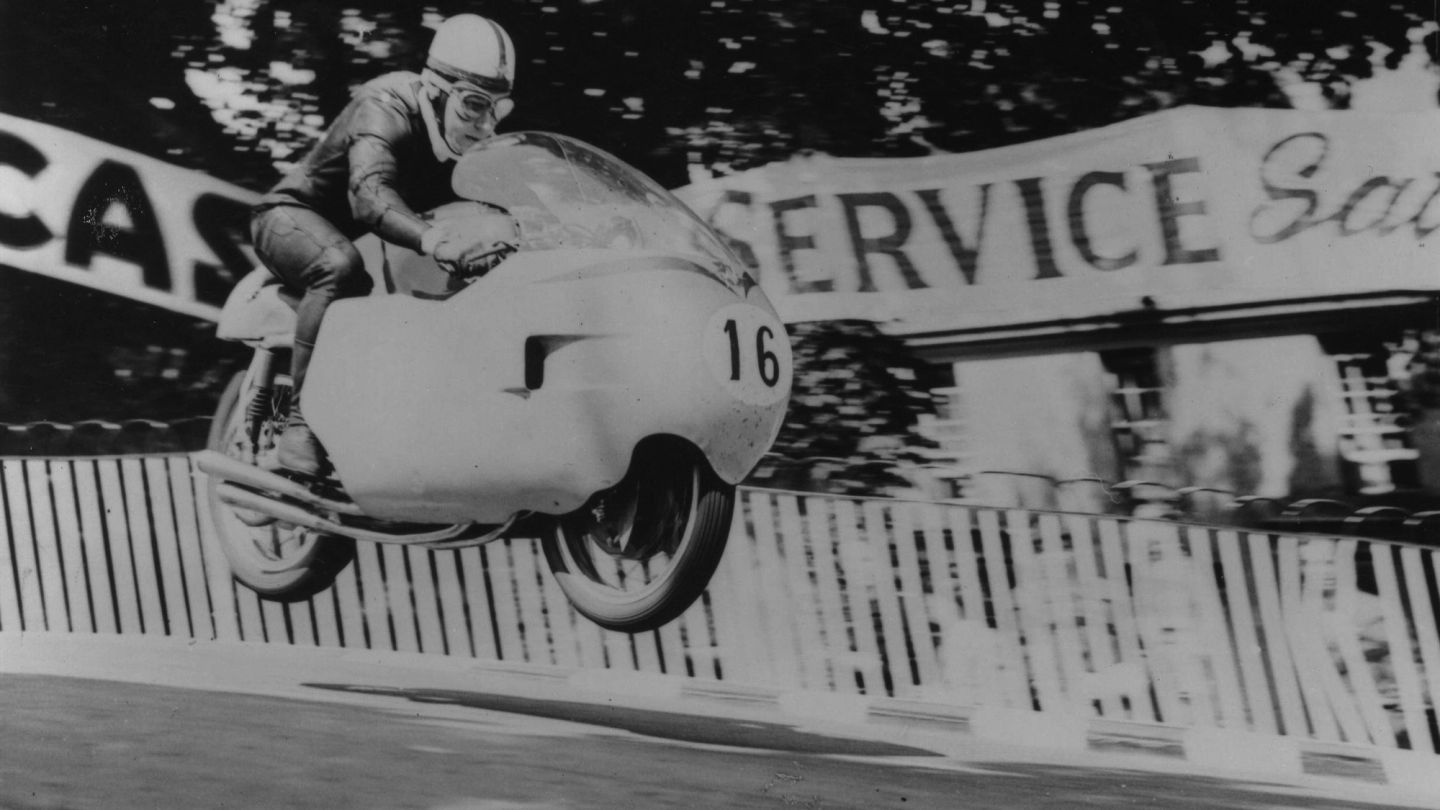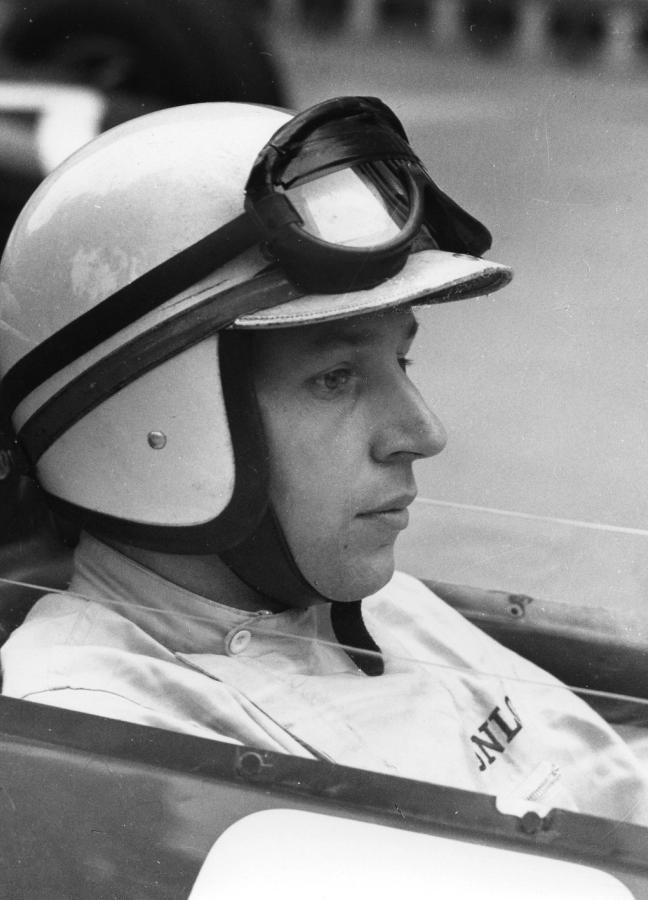

Words: Rory FH Smith
Talent is a word often misused in the world of sport. Defined as ‘an innate ability’ – something instinctual and inherited rather than learned – there are, in fact, very few people to whom the term can be correctly attributed. John Surtees CBE, however, is one of them.
I was fortunate enough to have met him. Initially, we were introduced in the race control building at Goodwood circuit – the very place where his four-wheeled career started in 1959. He smiled, shook my hand and we chatted a while. His slight frame was disguised under a full, blue race suit. The second meeting, rather bizarrely, was at a Battle of Waterloo-themed ball, where again he wore blue, only a full 19th-century Bourgeois court costume instead of a race suit. On the third, and what would turn out to be the final occasion I spoke to him, it was a glorious summer’s day. His memory and the way he articulated responses were as clear as the sky that day. What we’d planned to be a 20-minute interview turned into an hour-long discussion covering everything from his remarkable achievements to his deepest regrets.
Born on 11 February 1934, Surtees was well placed to be a young motorcycle champion. His father Jack had been a three-time British motorcycle sidecar champion and owned a motorcycle shop in south London. ‘I was around 11 or 12 years of age when my father said to me, “Lad, there’s a box of tools there and a box of parts over there – put it together and you can have it”.’ And with that, Surtees had earned his own 1932 Wallace Blackburn motorcycle. With a bike at the ready, it wasn’t far for Surtees and his father to travel out to Brands Hatch, the local racing circuit.
‘It was a grass track in those days but I used to race around the cinder track, outside of the grass circuit. It rained and I fell off on almost every corner. My father said, “Lad, I think it’s a little big for you”,’ he says fondly.
In the 1950s, Brands Hatch was tarmacked and turned into a road-racing circuit. ‘I used to race there on my 250 Triumph. There was another familiar chap who took part in that race, too. He was called Bernie Ecclestone.’
"It rained and I fell off on almost every corner. My father said, 'Lad, I think it’s a little big for you'..."
A few years senior to Surtees, Ecclestone was born in Suffolk but grew up in the town of Bexleyheath in south London. The two had first met when Surtees’ father arrived on Ecclestone’s doorstep in 1947 to purchase a 250cc Excelsior Manxman. Ecclestone was repairing the bike in the kitchen. Aged 17 at the time, he’d left school a year earlier to earn a living selling second-hand motorbikes. After that initial meeting, fate would have it that both Surtees and Ecclestone would cross paths many times.
As the son of a racer, mechanic and shop owner, Surtees opted to spend his school years with tools rather than textbooks. ‘I always loved working with spanners and making things. Perhaps I spent too long focusing on that instead of school,’ he says with a chuckle. Like Ecclestone, Surtees left school at 16, taking up an apprenticeship at Vincent Motorcycles. ‘I took my little Triumph bike down to Silverstone and the conrod broke half way through the first corner. That had me on my back and the engine in pieces. Then, a [broken] Vincent HRD came to me one day, for a good price. I was earning £2.10 a week back then, so I had bugger all to spare but I did some weekend work and put it back together. That was the launchpad to my career.’
It was around this time that Surtees’ innate ability to race came to fruition. ‘In the early 1950s, I took the bike to Wales and I came together with it. In a way, I became part of the bike. I was feeling it through the seat of my pants and the tips of my fingers. That’s the relationship you need to have with a machine to get the most out of it.’ It was this defining moment that marked the beginning of Surtees’ motorsport career.

‘By 1952, I had acquired a Norton and they asked me to do a major international event with it. I got my first championship points with that bike and went on to do more than 80 races between 1954 and 1955 before I joined the Norton team. With them, I took part in 74 races and I won 70 of them,’ he says nonchalantly. Winning, as is clear, came naturally to the young rider, setting him apart from the rest as a promising British sportsman.
In 1959, just short of 10 years on from the moment Surtees came together with the bike, he acquired his first taste of four-wheeled motorsport. ‘I was invited to go to Goodwood to race one day and I came second.’ He finished behind the legendary driver – but then promising beginner – Jim Clark. ‘After that, Colin Chapman, one of the founders of the UK motor-racing scene and Lotus boss, came up to me and asked if I’d try Formula One. I said I couldn’t, as I was doing motos at the time, but he simply replied: “Well, try it when you’re not!”’
With that, Surtees’ career in four-wheeled motorsport had begun. Before he’d barely become acquainted with the scene, he came second in the 1960 British Grand Prix. ‘I had no problems with the speed – that came naturally – but one of the biggest problems was getting to know people both on and off the track. It’s essential to know your competitors on track but it’s probably off track that I made some of my biggest mistakes,’ he admits.
In 1964, Surtees became the first World Champion on both two and four wheels. That year, “Fearless John”, as he came to be known, took victory at the notorious Nürburgring in Germany, while racing for Enzo Ferrari. But his high-flying career and newfound fame came with its own challenges.
"In a way, I became part of the bike. I was feeling it through the seat of my pants and the tips of my fingers. That’s the relationship you need to have with a machine to get the most out of it..."
Surtees had developed a reputation for being rather argumentative and hard to work with. After signing with Ferrari in 1963, for example, he’d never seen eye-to-eye with their manager Eugenio Dragoni, and he famously quit the team after a ferocious argument with Dragoni on the eve of the Le Mans 24-hour race in 1966. The affair had a significant impact on Surtees’ career, not to mention Ferrari’s result at Le Mans the following day, where all the team’s cars burnt out, failing to finish the race.
‘I think that I could have dealt with the situation with Ferrari in 1966 better,’ he recalls wistfully. ‘It was an emotional time for me.’
After his split with Ferrari, Surtees finished the 1966 season with Cooper before spending two years leading Honda’s new Formula One team. In 1969 he took the big decision to form his own team, and in 1973 he retired from driving himself in order to focus on running it. However, over nine Formula One seasons, Team Surtees’ highest result was only a second place. Despite his best efforts to keep the team going, Surtees eventually decided to leave the world of Formula One in 1978.
Turning his hand to property ventures and family life, Surtees was, for once, able to reflect on his life in the fast lane. All seemed well until the Surtees’ family life was upended in July 2009, when his son Henry, also a promising young racing driver, was tragically killed in a freak accident at Brands Hatch at the age of 18.
The accident changed the course of Surtees’ life. Re-engaging with the motorsport community, he championed the Henry Surtees Foundation, a charity he set up in memory of his son to assist people with accidental injuries.
‘Some things have changed for the better and some for the worse,’ he says of the sport over the decades. ‘There was a lot that went on in my career that wasn’t necessarily a good thing. Making the cars safer is a move for the better and the money and development going into this has been a great thing. The problem is that the technology doesn’t filter down, which is how my son was killed.’ He doesn’t lament on the point, but it brings to a close his short reflection, resulting in silence. It’s a reminder that for all the glitz and glamour of motorsport it has, on all too many occasions, resulted in tragedy.
Despite his remarkable achievements in British motorsport and his charity work, Surtees was never awarded a knighthood, unlike some of his peers. As unjust as that may seem to fans, his legacy within the sport and the wider community is far greater than any three-letter suffix could define. He conquered the art of piloting a two-wheeled superbike around primitive post-war circuits before transferring seamlessly to the top-end of four-wheeled motorsport. In both, he achieved World Champion status by the time he was 30. He led race teams, including his own, and battled with the political world of Formula One.,
Despite surviving the ‘killer years’ of motorsport, he unjustly suffered in his later years through the freak death of his only son. A grim motivation, perhaps, but his boundless charity work has touched the lives of many. The checkered flag may have fallen on the life of the multi-talented master of motorsport, but his legendary legacy lives on, in full Surtees spirit, forever.


